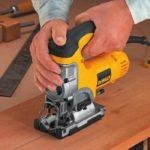Reciprocating saw blades are the blades that cut through material with a push and pull motion of the blade. We can use them for cutting through wood and metal quickly and cleanly. The number of teeth per inch (TPI) is the crucial factor to determine how smoothly or roughly it can cut the material. Reciprocating saw blades usually range from 3 to 24 TPI.
The number of teeth per inch determines the speed of cutting and roughness of cutting. However, if you have the right blades, that is, the suitable blades with you, you will find the task quite easy.
To help you in choosing right saw blades, we will provide you with some useful information regarding the features of some of the blades and when to use them. We will also write about different types of saw blades so that you know which one will be more suitable for your specific cutting.
Seven Consider when buying a Reciprocating saw blades [buying guide]
When you are going to buy Reciprocating saw blades you must remember the following:
Blade Material
We may find Reciprocating saw blades in the market which are made of different type of materials Like HCS, HSS, Bi-metal. Blades made from more durable material generally cost a little more to produce but last much longer.
Cheaper blades made of carbon steel may work excellent, but they are not stable and durable. In fact, the material will determine the suitability, utility, and durability of the blades.
The most common material is carbon steel, which is the most inexpensive and made out of steel. Steel reciprocating blades are more durable and flexible, and so they bend but don't break easily.
- High Carbon Steel (HCS)
- High-Speed Steel (HSS)
- Carbide Grit
- Bi-metal
Materials that the blade can cut
To cut different type of material are a part and parcel of our day to day life activities. In one's personal or professional life, he may need to cut various types of material.
We should remember that we cannot use a single type of blade for all kinds of cutting. So, we need various types of blades for different types of material as well as separate categories of cutting. There are different blades for wood cutting metal cutting, PVC etc.
We can generally apply different categories of blades for cutting the following elements:
- Tree branch cutting
- Framework
- Construction
- Demolition work
- Piping
- Metal cutting
- Home repairs (drywall for electrical wire placements, etc.)
Teeth-Per-Inch (TPI)
Teeth per inch are the most crucial factor when it comes to reciprocating saws. The number of blade teeth per inch of saws primarily decides how fast they will cut. Reciprocating saw blades typically range from 3 - 24 TPI.
The number of teeth per inch determines the cutting speed, smoothness, and roughness of cutting. The TPI of reciprocating saw blades that range from 3-8 is best for making rough cuts in wood.
Pruning blades naturally possess a very low TPI. 8-14 TPI blades are more suitable for cutting wood and the occasional nail. The range of PTI from 14-18 is ideal for cutting metal, and denser material as well as finish cut in wood.
Blades with higher TPI always remove smaller amounts of material with each pass. Although they cut slower, they leave a much smoother edge. The PTI range from 18-24 TPI is still the best for cutting metal.
The Blade Length
The length of reciprocating saw blade range from 3"-12". The standard measures are 4", 6", 8", 9" & 12". Among them the most common length is 6" 9" and 12" which are highly used and sold in the market.
Short blades are typically very strong and so more aggressive. The rigidity of short blades gives you a straighter and squarer cut. They are also suitable for plunge cutting, copper pipe, and thinner metals.
On the other hand, longer blades are more flexible and can disperse more heat as they have a large surface area. It is easier to perform Jobs like demolition, pruning, auto-dismantling, and rescue call with a longer blade.
The flexibility of longer blades also allows you to bend the blade when you need to cut a flush cut. The blade length should always be slightly longer than the thickness of the material you want to cut.
This reduces the slipping and binding situation of materials, and allows you to perform your task freely. If you use an excessive longer blade, it may vibrate violently and slow down your cut. Even it may ultimately damage your work and lead to bend blade.
Durability
Durability is an essential factor for any instrument. No one will spend money for buying blade every day. That's why he must check the strength of the blades before buying them. Depending on your reciprocating saw brand, you should try to buy your blades from the manufacturers or from the eminent shop.
Thicker and taller blades last longer, and also more pleasurable to use than blades that have more flex. You'll try to make sure if your reciprocating saw is up to the task.
Many people think that a flexible blade isn't durable. However, this idea isn't entirely right. In some cases, stiff blades break more efficiently with less force than those of a flexible one. You may think that a flexible blade will be a cause of annoying, but it won't affect the blade's durability.
To check the strength of a blade, you must check for the material it is made of. We have already stated enough about blade materials such as High-Speed Steel, Carbide Grit, and Bi-metal is more durable.
Final Judgment
The buying guide plays a vital role at the time of buying any product. If you want to buy a standard or quality reciprocating saw blade, you should sincerely read the buying guide. Reciprocating saw blades are suitable for cutting various types of materials.
If you want to perform a different kind of cut, you must use different categories of blade depending on the material. Whatever your purpose is, you should choose a suitable blade that can provide you with perfect performance, whether you want to use personally or in a large project.
We have researched some best reciprocating saw blades on the market and try to pick the perfect feature. Hopefully, the seven considerations cover most of the functionality of reciprocating saw blades, and you will find the vital information. You ever decide to purchase reciprocation saw blade, and it will help you decide which blade would be the best suitable for your cutting tasks.













